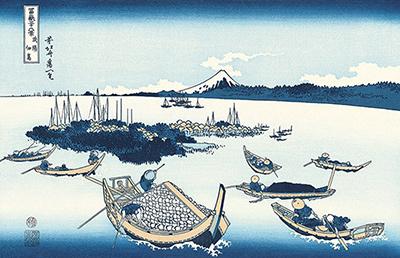Hokusai
Tsukuda Island in Musashi Province
Tsukuda Island in Musashi Province is a work of art created by Hokusai, who is widely considered to be one of the greatest artists that Japan has ever known. Working mainly with woodblocks and ink, Hokusais’s most famous work is probably The Great Wave (circa 1932).
Nevertheless, his work Tsukuda Island in Musashi Province is one of the gems of his opus. Hokusai lived between 1760 and died in 1849. He was born and died in Edo, which is now known as Tokyo. Tsukuda Island in Musashi Province depicts a scene in the Edo region, demonstrating Hokusai’s deep engagement with the natural world around him.
Tsukuda Island in Musashi Province is a very calm work of art. It depicts boats floating around the eponymous island. Fishermen can be seen working on the boats, and in the distance we see the green mountains with their white snow capped peaks. The rich, simple colours are very pleasant to behold and yet when the viewer looks more closely at the painting they see that it is a very intricate work of art.
Tsukuda Island in Musashi Province is often described as a rhythmic painting. It is given this title because of the way in which the form of one object will be reflected in the form of another object. For instance, the boat laden with cotton bales has a form that echoes that of Mt Fuji itself. There is thus a sense that everything is connected.
Tsukuda Island in Musashi Province is part of a wider series of paintings (of which the iconic ‘The Great Wave’ forms part) entitled ’36 Views of Mt Fuji’. Thus, though the mountain seems to be something of a background decoration in Tsukuda Island in Musashi Province, it is part of a series that revolves around Mt Fuji. Solemn and majestic, the presence of the mountain is felt in every one of the works of art in this series.
